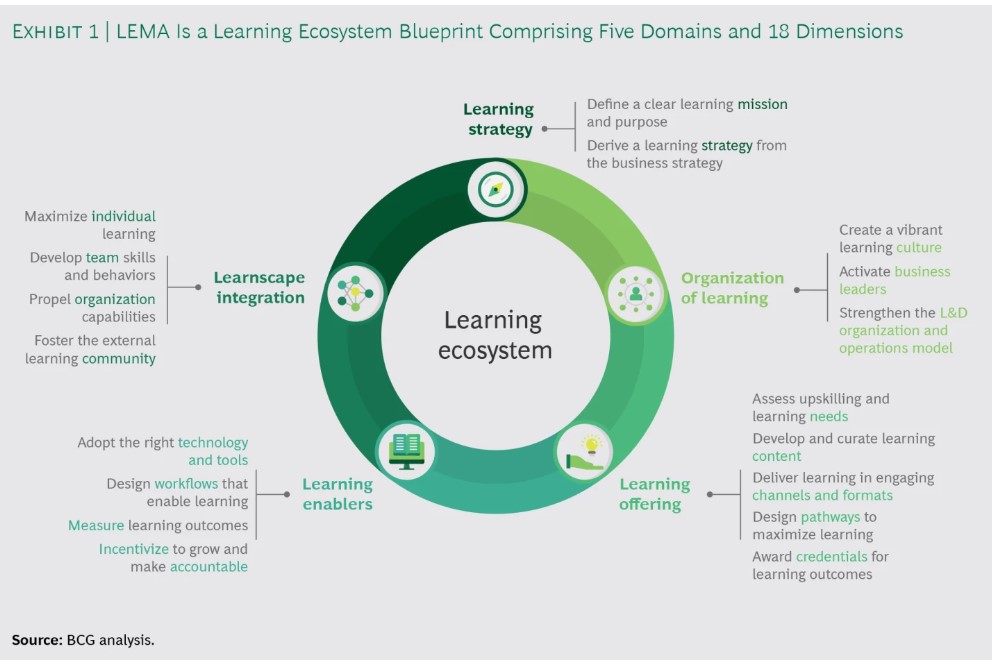6 Ways to Build A Culture of Learning in the Workplace

According to a BCG survey, 95% of companies agree that corporate learning is crucial to their future – but only 15% say L&D has been granted the high-priority status it deserves. This is where the challenge with workplace learning lies – we all know how vital it is but understanding how to embed and leverage a culture of learning in an organization can be a struggle.
What is a learning culture?
A learning culture within an organization refers to an environment and mindset where continuous learning, skill development, and knowledge sharing are not only encouraged but embedded in the organizational DNA. It reflects a commitment to ongoing education, improvement, and the collective pursuit of knowledge for the benefit of both individuals and the organization.
The definition you provided highlights key elements of a learning culture:
A learning culture is not an isolated effort; it involves the entire workforce. It's a collective commitment to learning and development.
A growth mindset is essential. Individuals within the organization are open to learning, adapting, and embracing challenges as opportunities for growth.
- Desire to Learn and Apply Knowledge:
In a positive learning culture, individuals have a genuine desire to learn, and there's an understanding that acquiring knowledge is not an end in itself but a means to contribute to the success of the organization.
Learning is not confined to individual silos. Instead, there is a culture of sharing knowledge, insights, and expertise among colleagues, fostering collaboration and a sense of community.
- Alignment with Business Goals:
A learning culture is aligned with the organization's broader business goals. Learning and development efforts are directed toward enhancing skills and competencies that contribute to the success of the company.
- Leadership and Management Support:
Leaders and managers play a crucial role in championing a learning culture. Their active support and endorsement of continuous learning set the tone for the entire organization.
In a positive learning culture, employees are not passive recipients of training but are actively involved in their own learning journeys. They take ownership of their development.
- Knowledge Sharing as a Norm:
Knowledge sharing is not just encouraged; it becomes a norm. There's a recognition that collective knowledge is a valuable asset that benefits everyone.
- Positive Learning Environment:
The learning environment is positive and conducive to growth. It encourages curiosity, experimentation, and a willingness to learn from both successes and failures.
A learning culture is dynamic and adaptable. It emphasizes continuous improvement and staying current with industry trends and best practices.
- Championed by Leadership:
Leadership actively champions and invests in learning initiatives. It is seen as a strategic priority rather than a discretionary effort.
A culture of learning is important because most of the organizations are worried about retention. When employees feel that their professional development is a priority, they are more likely to be motivated, committed, and satisfied in their roles. Another reason is that a learning culture encourages employees to explore new ideas, experiment with different approaches, and stay informed about industry trends. Third, the best employees actively seek out companies that want to invest in their personal development.
How to create (and maintain) a culture of learning?
1. Leadership buy-in
Leaders need to help their teams realize that L&D is part of their working day. Be the example so others can follow.
Pro tip: Consider placing a compulsory learning time block in every employee’s calendar. Ensure that no meetings, customer calls, or other distractions can interfere with L&D. An approach like this signals that learning is equally as important as other work projects.
2. Communication
Talking to the team!
Good communication and a buy-in from the people actually doing the courses is an integral step to success. If your teams are struggling with their current workloads, just assuming that they’ll take on additional L&D isn’t going to help with engagement and implementation.
3. Collaboration and engagement
The most successful learning cultures are the ones with a lot of activity around the training.
Tips: Allocate 10 minutes in an already established team meeting to discuss learning; make learning more of an event.
4. Time management
According to a LinkedIn survey, getting employees to make time for learning is the number one challenge facing talent development. Try to block a specific time (perhaps there’s 15-minutes at the start of each day you can lock in?).
5. Recognize and reward
Acknowledge and celebrate the accomplishments of employees who actively engage in learning. This could involve creating a recognition program, highlighting learning milestones during team meetings, or offering incentives for completing certain training programs. Recognizing and rewarding learning achievements reinforces the importance of continuous development.
6. Measure and track the metrics
You cannot improve what you cannot measure. Start by Implementing key performance indicators (KPIs) to track the impact of learning initiatives on individual and organizational performance. Measure metrics such as employee satisfaction, productivity, and completion rates to see the effectiveness of the learning culture. And regularly review this data to make informed adjustments to your learning strategies.

READ THE 18 DIMENSIONS OF SUCCESS